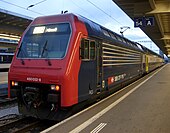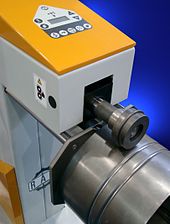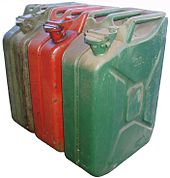Bead
Beads are channel-shaped depressions that are often used to stiffen thin-walled components against deformation or vibration. Corrugations driven into plastically deformable material (e.g. sheet metal ) are also referred to as embossing . In the body shop , stiffening beads often also have a design function.
Cylindrical components such as pipes and vessels such as food cans can be stiffened both by circumferential beads and by beads in the longitudinal direction.
Instead of beads, thin-walled components are now increasingly reinforced by glued or welded strips.
Linear stiffeners or linear protruding or recessed ornaments in solid material are not referred to as beads, but rather as ribs.

A special case are beads on the cardboard or plastic cone of electrodynamic loudspeakers. Here the cone itself is already sufficiently stiff. To make it vibrate, the outer circumference of the cone is provided with an embossed bead or a surrounding bead ring made of a softer material is attached to the stiffer cone.
production
The bead is pressed into the sheet manually with a beading hammer on a beading block or mechanically with a beading machine with the help of two beading rollers . There are beading rolls for different shapes. Beading is of great importance in body construction: There they are used to avoid droning noises in large, flat sheet metal, but above all to locally stiffen the entire body. Correctly designed, beads can also reduce stress peaks in the sheet metal caused by forming processes. So-called ruffles play a special form . These beads are used to take up excess sheet metal material during deep drawing and thus to avoid surface defects and wrinkling (consumption beads ). The effectiveness of a bead essentially depends on the following factors:
- Position of the bead, shape, course, radii, arrangement of different beads to one another.
Furthermore, it must be checked what load a buried sheet metal is exposed to. The following types of exposure usually occur:
- Torsion , thrust, normal force.
There is no such thing as an "ideal" bead, but some principles apply:
- An imaginary cut through a buried sheet metal must always cut at least one bead.
- Crossings of diagonal beads should be avoided, as they may reduce the rigidity and create stress peaks in the nodes (the X-bead, which is often used, is therefore a structurally unfavorable solution).
- The more uneven the bead, the greater the stiffening effect.
- Sheets with a rectangular circumference should be provided with round beads and vice versa.
Loudspeaker construction
In electrodynamic loudspeakers , the outer articulated part on the cone is called a bead. The bead is used for the airtight, flexible connection of the cone with the basket and the seal that runs around the basket. Depending on the application, it consists of different materials ( paper , rubber , textile, etc.). In rubber and foam, their cross-section is usually curved in a semicircular cross-section. B. a wavy line in cross section. Loudspeaker surrounds are subject to wear and tear due to the constant bending load and are often replaced together with the cone, voice coil and spider.

